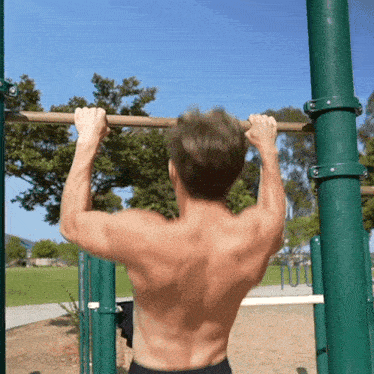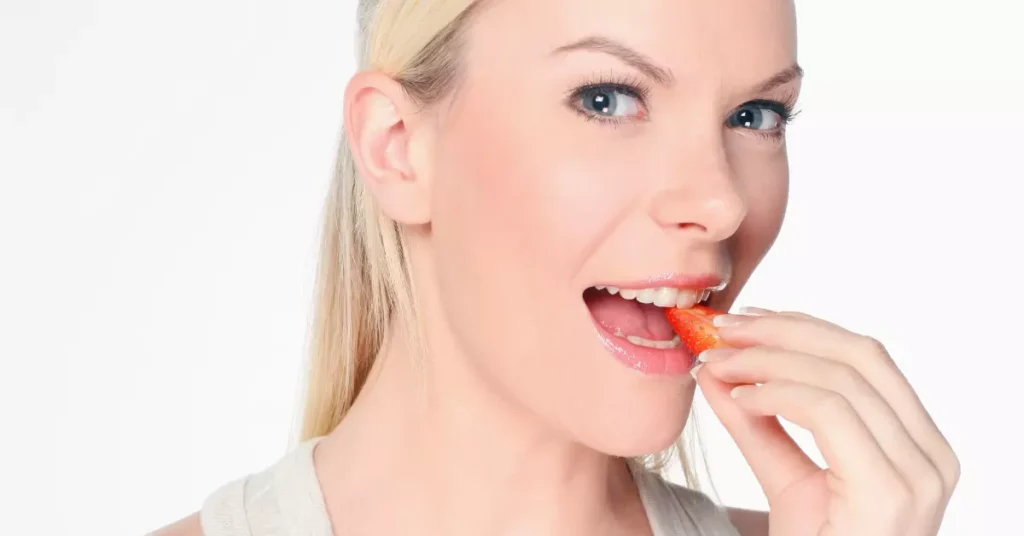Wondering what muscles do pull ups work? Learn the benefits of pull ups, how to do pull-ups at home and find answers to the most asked questions!

I always thought Pull-ups were one of the most impressive exercises to watch others performing at my gym.
Some guys made it look so easy. They seemed to have super-human strength to repeatedly glide up and over the bar, keeping their legs and torsos tight.
Pull-ups are a great exercise to build strength and work out multiple groups of upper-body muscles.
Learn all about Pull Ups in our guide, where we cover everything, including the benefits of Pullups, different types, and more, and how they can give your workout routine a boost.
What is a Pull Up?
In basic terms, a Pull Up is an upper-body exercise involving gripping an overhead horizontal bar and pulling your whole body up towards the bar.

Getting more technical, Pull Ups are considered ‘closed-chain’ movements in exercise-speak.
‘Closed-chain’ means the feet or hands remain in constant contact with a surface – in this case, the overhead horizontal bar.
Typically, you place your hands on the bar wider than the shoulders for a standard Pull Up.
The most common hand grip is a ‘pronated’ grip and is essentially an overhand grip. There are, however, grip variations that can change the muscle groups worked during the exercise.
Common Grip Variations –
- Pronated or Overhand Grip (Fingers over the bar, palms facing away from you)
- Supinated or Underhand Grip (Palms face toward you)
- Mixed Grip (One hand uses a Pronated Grip, the other a Supinated Grip)
- Neutral Grip (Grip a suitable bar with parallel handles where hands can face each other)
Also Read- Garlic Benefits for Men, Sexually and otherwise!
Variations / Types of Pull ups
Once you have gained the strength to master a standard Pull Up, you might like to try one of the many variations of this powerful exercise.
Variations of Pull Ups incorporate elements such as a change in the type of bar used, hand width or spacing on the bar and, as mentioned above, the type of grip used.
Each of these variations will utilise and strengthen different muscles.
So if you have conquered the basic Pull Up, why not work towards these other types of pull ups (And some of these variations also have variations!) –
- Weighted Pull Up (add weights to your body via a belt, vest or suitable exercise accessory)
- Scapular (or Scapula) Pull Up (Activate your shoulder blades without bending your elbows to try to lift the body to the bar)
- Pull-Up with Leg Raises (Pull yourself toward the bar as with a standard Pull Up, then contract the abdominal muscles and raise your legs to 90 degrees).
- Around the World Pull Up (Start in the standard position gripping the bar, then pull upwards with the right or left hand, shift across the bar and lower down)
- One Arm (Yes, some people can perform a Pull Up with one arm!)
Are Pull Ups the same as Chin Ups?

That’s a good question. It depends on who you ask.
The exercises look almost the same.
But there is an important distinction that affects the muscles utilised.
It’s all about the hand position on the bar.
Put simply, a hand grip over the bar (palms facing away from you) is what most people refer to as a standard Pull Up.
Whereas A Chin Up is the same move, with the grip under the bar (palms facing you).
(However, some exercise specialists use the word ‘Pull Ups’ as a general term to encompass overhead pulling exercises plus the variations).
Why are Pull Ups a Good Exercise?
Apart from impressing the gym crowd, Pull ups are good exercises to increase upper body strength and work multiple muscle groups.
Even those who do not yet have the strength to perform them optimally; can get the benefits of pullups.
Here are the main benefits of Pull Ups –
- Increase Grip Strength. Poor grip strength is regularly associated with increases mortality in older people (One study has demonstrated grip strength to be a more significant predictor of cardiovascular mortality than systolic blood pressure!) Also Read- What fruits to eat if you have diabetes.
- Work out Multiple Muscle Groups. Pull Ups are known as a ‘compound’ exercise. This type of exercise type involves multiple muscle groups. Pull Ups, for example, work muscles in the arms, back and torso.
- Options for Strength Levels. The starting strength required can sometimes deter people from attempting Pull Ups. However, several ‘tweaks’ and variations are available for different skill and strength levels.
- Affordable and accessible – Another one of the many benefits of pullups is you only need a high bar able to carry your weight. Pull Ups can therefore be performed in a gym setting, outdoors (using park equipment, for example) or at home on a suitable bar. No other special or expensive equipment is required!
What Muscles Do Pull Ups Work?
Now, let’s explore which muscles you actually use when you do pull ups?
Instead of performing different moves for each area, Pull Ups work muscles in the arms, back, and even that pesky abdominal zone!
Strength is required in each area to perform a standard Pull Up.
If you are targeting specific muscle groups, read on to learn about the benefits of pullups for each group.
‘Lats’ (Latissimus dorsi)
Latissimus dorsi, more commonly referred to as ‘Lats,’ are the Big Daddy of the back muscles.
Lats are the primary muscle worked during a Pull Up.
They run down the side of the spine, below the shoulder blade.
‘Lats’ give that broad ‘V’ shape to the torso.
Pull Ups are perfect to strengthen and grow the Lats.
As you pull up with your arms, the Lats work by pulling your arms towards the middle of the body, elevating you upwards towards the bar.
Biceps
The next major muscle that gets worked during Pull Ups is the Biceps.
If you want some strong, nicely defined ‘guns,’ then Pull Ups are perfect!
Variations of hand grip and bar positioning can work the biceps further.
Forearms
Anyone who has tried to perform a Pull Up will know your forearms take some major strain.
Simply hanging from the bar (or gripping anything) involves the forearm muscles.
You will feel different muscles activate when you try different grips, bar sizes and hand positions on the bar doing Pull Ups.
With the forearms, the closer the grip, the more forearm muscles are utilised.
‘Traps’(Trapezius)
The ‘traps’ (or trapezius) muscles are a group of muscles found in the back. (The muscles form a ‘trapezoid’ shape, hence the name).
They work together, with the ‘Lats’ and the Rhomboids, to assist stability in the shoulder.
Source – By Mikael Häggström, used with permission
‘Pecs’ (Pectoral)
Who doesn’t want better pecs? A strong, defined chest is often a goal of many a gym goer.
The benefits of pullups are that the muscles on the chest get activated, both during the upward trajectory and more so during the lowering or downward phase of the move.
Source – CC BY-SA 3.0
Abdominal Muscles
You might not think at first that your abdominal region gets a workout when performing Pull Ups – it’s all arms and back, aren’t they?
Not so. The abdominals work extensively during the Pull Up motion, working to keep the legs stable as well as the whole torso, to allow the arms and back to drive upwards efficiently.
Pull Ups are a serious workout for your abdominals.
Rhomboids
Source – modified by Uwe Gille – Gray Image:Gray409.png, Public Domain
The rhomboids play an important stabilising function for the shoulder blade.
Located behind the tapezius, the rhomboids work during the Pull Up motion to allow movement in the shoulder to remain secure, moving with the variations of hand grips and width of hand position etc.
Teres Major
This muscle works by pulling your arms downwards toward the body and assists the function of the ‘Lats.’
It is located on your upper back, connecting the upper arm to the shoulder area.
People involved in certain throwing sports or activities, for example, may be interested in strengthening their muscles.

Source – Anatomography – CC BY-SA 2.1 jp
How to do Pull Ups for Beginners at Home
Pull Ups are not for the faint-hearted. And, it might please you to know that most people cannot perform a Pull Up when they first try.
This challenging exercise requires a lot of strength and the correct technique. They may be very intimidating for beginners, however, there is hope.
Those who wish to perform a standard Pull Up one day can start with Negative Pull Ups.
These are essentially the opposite of a pull up – you start up, and lower yourself downwards slowly.
They work the same muscles as a regular Pull Up however they are a little easier for those without the full strength to perform the standard version.
At first you may not have the strength to hold yourself up and simply drop quite fast to a hanging position (like I did when I first tried!).
But over time, your strength will increase, and you will be able to hold yourself for a longer time at the top and then lower yourself down for over a slow count.
A Negative Pull Up can be performed by first standing on something (stable chair, workout bench etc.) to grip the bar and have your chin over the bar, then lowering yourself as slowly as possible.
(Another option for beginners is ‘Assisted Pull Ups’ using a resistance band, however, you may need the right equipment and a trainer or assistant to perform these safely).
How to train to do a pull-up
The Negative Pull Ups described above is a great way to train to perform regular standard Pull Ups.
Other options are any exercise that works for the main muscle groups in the upper body, such as arms, back and abdominals.
Some examples include –
- Rows
- Plank
- Hold exercises (hollow, hanging etc)
- Lat pulldowns
- Also read our blog on Weight Loss Exercises at Home for Beginners
Precautions
Always check with your trainer or exercise consultant for the best way to prepare for an exercise for your specific fitness condition, especially if it’s new to you.
Any exercise could cause injury if not performed correctly. You should consider your specific level of strength when attempting a Pull Up.
Using an incorrect grip or hand position on the bar could lead to strains or worse.
Given you are trying to pull your entire body weight upwards, it can cause an enormous load on various upper body muscles.
If you are new to Pull Ups it is best to get professional advice and assistance to avoid being out of the gyms for weeks (or in the hospital!)
FAQs About Pull-ups
Do Pull Ups Work the Chest?
Yes. Pull Ups work the chest by engaging the ‘Pecs’ or pectoral muscles that run across the front of the chest.
Both the upward and downward motion of a Pull Up utilise and strengthen the muscles in the chest.
Do pull-ups actually build muscle?
Just using muscles will strengthen and build muscles over time. Pull-ups require great strength to perform exercise optimally.
Pull Ups will build muscle as you lift your entire body weight (and you can always add weight to increase the load).
If you want to accelerate or increase muscle growth beyond Pull Ups, use heavy weights with optimal reps to achieve muscle building more quickly.
Is 20 Pull Ups a day a good goal?
This answer will depend on a number of factors, including your fitness level.
Not everyone should train every day. It depends on your overall fitness regime and recovery period requirements.
If you are suitably fit and can perform many Pull Ups per day (without going to ‘failure’), then 20 may be suitable.
For others, a lower amount of reps would still create benefits.
Do Pull Ups work biceps?
The biceps are the primary muscle worked (aside from the Lats) when performing Pull Ups.
Variations of the exercise may work the biceps more, for example, an underhand grip (Chin Up)
Pull Ups are one of the best ways to grow and strengthen bicep muscles.
━━━━ continue after the ad ━━━━
━━━━━━━━━━━━━━━━
References
- https://www.ncbi.nlm.nih.gov/pmc/articles/PMC6778477/
- https://en.wikipedia.org/wiki/Pull-up_(exercise)
- https://www.blackridgefitness.com/pull-ups-muscles-worked/



TAGS:

Jennifer is the co-founder of menPsyche. She holds an Applied Science degree in Public Health & Health Promotion and authored the ‘Personal Disaster’ book series.
Jennifer has a vast range of experience across many domains, including extensive international exposure.



